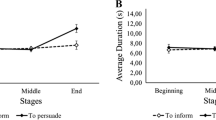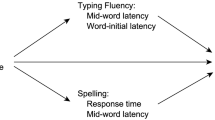Abstract
Investigating links between temporal features of the writing process (e.g., bursts and pauses during writing) and the linguistic features found in written products would help us better understand intersections between the writing process and product. However, research on this topic is rare. This article illustrates a method to examine associations between the writing process and linguistic features and provides an illustrative study that examines whether features of L2 writing fluency can be predicted by cohesive devices produced in argumentative essays. Seventy-five L2 undergraduate students at a U.S. university wrote two independent essays spaced about five months apart on two different prompts. Students' writing fluency was calculated using keystroke logging techniques and was analyzed using a multi-dimensional model that condensed processing into four process components (production, process variance, revision, and pause behavior). The cohesion features in students’ essays were analyzed using natural language processing (NLP) approaches that measured three types of cohesive devices (reference, conjunction, lexical cohesion). Results from linear mixed effects models showed that writing fluency components were significantly predicted by a set of cohesive devices found in L2 writers' essays. The findings indicated links between certain cohesive devices and specific temporal features in L2 writers' text production (e.g., more unattended demonstratives related to more productivity). The proposed method affords opportunities for future research investigating links between the writing process and product using keystroke logging and NLP.
Similar content being viewed by others
Notes
Note that in addition to these three categories, Halliday and Hasan's (1976) framework also includes substitution and ellipsis. These two types of cohesive devices were not discussed in this study because they are particularly characteristic of cohesion features in dialogue (Halliday & Matthiessen, 2013).
References
Abdel Latif, M. M. (2009). Toward a new process-based indicator for measuring writing fluency: Evidence from L2 writers’ think-aloud protocols. Canadian Modern Language Review, 65(4), 531–558. https://doi.org/10.3138/cmlr.65.4.531
Abdel Latif, M. M. (2013). What do we mean by writing fluency and how can it be validly measured? Applied Linguistics, 34(1), 99–105. https://doi.org/10.1093/applin/ams073
Baayen, R. H., Davidson, D. J., & Bates, D. M. (2008). Mixed-effects modeling with crossed random effects for subjects and items. Journal of Memory and Language, 59(4), 390–412. https://doi.org/10.1016/j.jml.2007.12.005
Bates, D., Maechler, M., Bolker, B., & Walker, S. (2015). lme4: Linear mixed-effects models using Eigen and S4_. R package version 1.1–9. Retrieved from https://CRAN.R-project.org/package=lme4
Blei, D. M., Ng, A. Y., & Jordan, M. I. (2003). Latent dirichlet allocation. The Journal of Machine Learning Research, 3, 993–1022.
Bruton, D. L., & Kirby, D. R. (1987). Research in the classroom: Written fluency: Didn’t we do that last year? The English Journal, 76(7), 89–92. https://doi.org/10.2307/818661
Chandler, J. (2003). The efficacy of various kinds of error feedback for improvement in the accuracy and fluency of L2 student writing. Journal of Second Language Writing, 12(3), 267–296. https://doi.org/10.1016/s1060-3743(03)00038-9
Chandrasekaran, D., & Mago, V. (2021). Evolution of semantic similarity—A survey. ACM Computing Surveys (CSUR), 54(2), 1–37.
Chenoweth, N. A., & Hayes, J. R. (2001). Fluency in writing: Generating text in L1 and L2. Written Communication, 18, 80–98. https://doi.org/10.1177/0741088301018001004
Chenoweth, N. A., & Hayes, J. R. (2003). The inner voice in writing. Written Communication, 20(1), 99–118. https://doi.org/10.1177/0741088303253572
Chukharev-Hudilainen, E., Saricaoglu, A., Torrance, M., & Feng, H. H. (2019). Combined deployable keystroke logging and eyetracking for investigating L2 writing fluency. Studies in Second Language Acquisition, 41(3), 583–604. https://doi.org/10.1017/s027226311900007x
Clark, B. (2017). Cohesion in systemic functional linguistics: A theoretical reflection. In T. Bartlett & G. O’Grady (Eds.), The routledge handbook of systemic functional linguistics (pp. 404–417). Routledge.
Cohen, J. (2013). The impact of topic selection on writing fluency: Making a case for freedom. Journal of NELTA, 18(1–2), 31–40. https://doi.org/10.3126/nelta.v18i1-2.10328
Crossley, S. A., Allen, L. K., Kyle, K., & McNamara, D. S. (2014). Analyzing discourse processing using a Simple Natural Language Processing Tool. Discourse Processes, 51(5–6), 511–534. https://doi.org/10.1080/0163853x.2014.910723
Crossley, S. A., Kyle, K., & Dascalu, M. (2019). The tool for the automatic analysis of cohesion 2.0: Integrating semantic similarity and text overlap. Behavior Research Methods, 51(1), 14–27. https://doi.org/10.3758/s13428-018-1142-4
Geisler, C., Kaufer, D. S., & Steinberg, E. R. (1985). The unattended anaphoric “This.” Written Communication, 2(2), 129–155. https://doi.org/10.1177/0741088385002002002
Graesser, A. C., McNamara, D. S., Louwerse, M. M., & Cai, Z. (2004). Coh-metrix: Analysis of text on cohesion and language. Behavior Research Methods, Instruments, & Computers, 36(2), 193–202. https://doi.org/10.3758/bf03195564
Gutwinski, W. (1976). Cohesion in literary texts: A study of some grammatical and lexical features of English discourse. Mouton.
Halliday, M. A. K., & Hasan, R. (1976). Cohesion in English. Longman.
Halliday, M. A. K., & Matthiessen, C. M. (2013). Halliday’s introduction to functional grammar. Routledge.
Hayes, J. R., & Chenoweth, N. A. (2007). Working memory in an editing task. Written Communication, 24, 283–294. https://doi.org/10.1177/0741088307304826
Hinkel, E. (2004). Teaching academic ESL writing. Lawrence Erlbaum.
Hoey, M. (2005). Lexical priming: A new theory of words and language. Routledge.
Hu, C., & Li, Y. (2015). Discourse connectives in L1 and L2 argumentative writing. Higher Education Studies, 5(4), 30–41. https://doi.org/10.5539/hes.v5n4p30
Just, M. A., & Carpenter, P. A. (1980). A theory of reading: From eye fixations to comprehension. Psychological Review, 87(4), 329–354. https://doi.org/10.1037/0033-295x.87.4.329
Kaufer, D. S., Hayes, J. R., & Flower, L. (1986). Composing written sentences. Research in the Teaching of English, 20, 121–140.
Kellogg, R. T. (1996). A model of working memory in writing. In C. M. Levy & S. E. Ransdell (Eds.), The science of writing: Theories, methods, individual differences and applications (pp. 57–71). Lawrence Erlbaum.
Knoch, U., Rouhshad, A., Oon, S. P., & Storch, N. (2015). What happens to ESL students’ writing after three years of study at an English medium university? Journal of Second Language Writing, 28, 39–52. https://doi.org/10.1016/j.jslw.2015.02.005
Kowal, I. (2014). Fluency in second language writing: A developmental perspective. Studia Linguistica Universitatis Iagellonicae Cracoviensis., 131(2014), 229–246. https://doi.org/10.4467/20834624SL.14.013.2321
Kuznetsova, A., Brockhoff, P. B., & Christensen, R. H. B. (2015). Package ‘lmertest’. R package version, 2(0).
Landauer, T. K., & Dumais, S. T. (1997). A solution to Plato’s problem: The latent semantic analysis theory of acquisition, induction, and representation of knowledge. Psychological Review, 104(2), 211–240. https://doi.org/10.1037/0033-295x.104.2.211
Leijten, M., Van Horenbeeck, E., & Van Waes, L. (2019). Analysing keystroke logging data from a linguistic perspective. In E. Lindgren & K. P. H. Sullivan (Eds.), Observing Writing (pp. 143–162). Brill. https://doi.org/10.1163/9789004392526_005
Leijten, M., & Van Waes, L. (2013). Keystroke logging in writing research: Using Inputlog to analyze and visualize writing processes. Written Communication, 30(3), 358–392. https://doi.org/10.1177/0741088313491692
Leijten, M., & Van Waes, L. (2015). Inputlog Manual 8.0. Retrieved from http://www.inputlog.net/wp-content/uploads/Inputlog_manual.pdf.
Levy, C. M., & Ransdell, S. (1995). Is writing as difficult as it seems? Memory & Cognition, 23(6), 767–779. https://doi.org/10.3758/BF03200928
Limpo, T., & Alves, R. A. (2017). Written language bursts mediate the relationship between transcription skills and writing performance. Written Communication, 34(3), 306–332. https://doi.org/10.1177/0741088317714234
Liu, M., & Braine, G. (2005). Cohesive features in argumentative writing produced by Chinese undergraduates. System, 33(4), 623–636. https://doi.org/10.1016/j.system.2005.02.002
Medimorec, S., & Risko, E. F. (2016). Effects of disfluency in writing. British Journal of Psychology, 107(4), 625–650. https://doi.org/10.1111/bjop.12177
Mikolov, T., Sutskever, I., Chen, K., Corrado, G., & Dean, J. (2013, December). Distributed representations of words and phrases and their compositionality. In Proceedings of the 26th International Conference on Neural Information Processing Systems-Volume 2 (pp. 3111–3119).
Miller, G. A., Beckwith, R., Fellbaum, C., Gross, D., & Miller, K. J. (1990). Introduction to WordNet: An on-line lexical database. International Journal of Lexicography, 3(4), 235–244. https://doi.org/10.1093/ijl/3.4.235
Nakagawa, S., & Schielzeth, H. (2013). A general and simple method for obtaining R2 from generalized linear mixed-effects models. Methods in Ecology and Evolution, 4(2), 133–142. https://doi.org/10.1111/j.2041-210x.2012.00261.x
Olive, T., Alves, R. A., & Castro, S. L. (2009). Cognitive processes in writing during pause and execution periods. European Journal of Cognitive Psychology, 21(5), 758–785. https://doi.org/10.1080/09541440802079850
Palviainen, Å., Kalaja, P., & Mäntylä, K. (2012). Development of L2 writing: Fluency and proficiency. AFinLA-E: Soveltavan Kielitieteen Tutkimuksia, 4, 47–59.
Perrin, D. (2019). Progression analysis: Working with large data corpora in field research on writing. In E. Lindgren & K. P. H. Sullivan (Eds.), Observing Writing (pp. 143–162). Brill. https://doi.org/10.1163/9789004392526_008
R Core Team. (2015). R: A language and environment for statistical computing. Vienna, Austria: R Foundation for Statistical Computing. Retrieved from https://www.R-project.org/. https://doi.org/10.1016/j.dendro.2009.12.001
Reid, J. (1992). A computer text analysis of four cohesion devices in English discourse by native and nonnative writers. Journal of Second Language Writing, 1(2), 79–107. https://doi.org/10.1016/1060-3743(92)90010-M
Rustipa, K. (2015). The use of demonstrative pronoun and demonstrative determiner this in upper-level student writing: A case study. English Language Teaching, 8(5), p158. https://doi.org/10.5539/elt.v8n5p158
Schilperoord, J. (1996). It's about time: Temporal aspects of cognitive processes in text production (Vol. 6). Rodopi.
spaCy Core Team. (2017). Industrial-strength Natural Language Processing in Python. Retrieved from https://spacy.io/
Spelman Miller, K. (2000). Academic writers on-line: Temporal features of first and second language written text production. Doctoral thesis. University of Reading, England.
Spelman Miller, K., Lindgren, E., & Sullivan, K. P. (2008). The psycholinguistic dimension in second language writing: Opportunities for research and pedagogy using computer keystroke logging. Tesol Quarterly, 42(3), 433–454. https://doi.org/10.1002/j.1545-7249.2008.tb00140.x
Slabakova, R., White, L., & Brambatti Guzzo, N. (2017). Pronoun interpretation in the second language: Effects of computational complexity. Frontiers in Psychology, 8, 1236. https://doi.org/10.3389/fpsyg.2017.01236
Stevenson, M., Schoonen, R., & De Glopper, K. (2006). Revising in two languages: A multi-dimensional comparison of online writing revisions in L1 and FL. Journal of Second Language Writing, 15(3), 201–233. https://doi.org/10.1016/j.jslw.2006.06.002
Sugita, Y. (2012). Enhancing students’ fluency in writing: Learning to use transition words. Open Journal of Modern Linguistics, 2(01), 18. https://doi.org/10.4236/ojml.2012.21003
Swales, J. M. (2005). Attended and unattended “this” in academic writing: A long and unfinished story. ESP Malaysia, 11, 1–15.
Taylor, K. S., Lawrence, J. F., Connor, C. M., & Snow, C. E. (2019). Cognitive and linguistic features of adolescent argumentative writing: Do connectives signal more complex reasoning? Reading and Writing, 32(4), 983–1007. https://doi.org/10.1007/s11145-018-9898-6
Van Waes, L., & Leijten, M. (2015). Fluency in writing: A multidimensional perspective on writing fluency applied to L1 and L2. Computers and Composition, 38, 79–95. https://doi.org/10.1016/j.compcom.2015.09.012
Van Waes, L., & Schellens, P. J. (2003). Writing profiles: The effect of the writing mode on pausing and revision patterns of experienced writers. Journal of Pragmatics, 35(6), 829–853. https://doi.org/10.1016/S0378-2166(02)00121-2
Van Weijen, D., Van den Bergh, H., Rijlaarsdam, G., & Sanders, T. (2009). L1 use during L2 writing: An empirical study of a complex phenomenon. Journal of Second Language Writing, 18(4), 235–250. https://doi.org/10.1016/j.jslw.2009.06.003
Waltz, D. L., & Pollack, J. B. (1985). Massively parallel parsing: A strongly interactive model of natural language interpretation. Cognitive Science, 9(1), 51–74. https://doi.org/10.1016/S0364-0213(85)80009-4
Wengelin, A. (2001). Disfluencies in Writing-are they Like in Speaking?. In ISCA Tutorial and Research Workshop (ITRW) on Disfluency in Spontaneous Speech.
Wengelin, A. (2002). Text production in adults with reading and writing difficulties. Gothenburg University.
Wengelin, A. (2006). Examining pauses in writing: Theories, methods and empirical data. In K. P. H. Sullivan & E. Lindgren (Eds.), Computer key-stroke logging and writing: methods and applications (pp. 107–130). Elsevier.
Wolfe-Quintero, K., Inagaki, S., & Kim, H. Y. (1998). Second language development in writing: Measures of fluency, accuracy & Complexity. University of Hawaii.
Author information
Authors and Affiliations
Corresponding author
Additional information
Publisher's Note
Springer Nature remains neutral with regard to jurisdictional claims in published maps and institutional affiliations.
Supplementary Information
Below is the link to the electronic supplementary material.
Rights and permissions
About this article
Cite this article
Tian, Y., Kim, M., Crossley, S. et al. Cohesive devices as an indicator of L2 students' writing fluency. Read Writ 37, 419–441 (2024). https://doi.org/10.1007/s11145-021-10229-3
Accepted:
Published:
Issue Date:
DOI: https://doi.org/10.1007/s11145-021-10229-3




